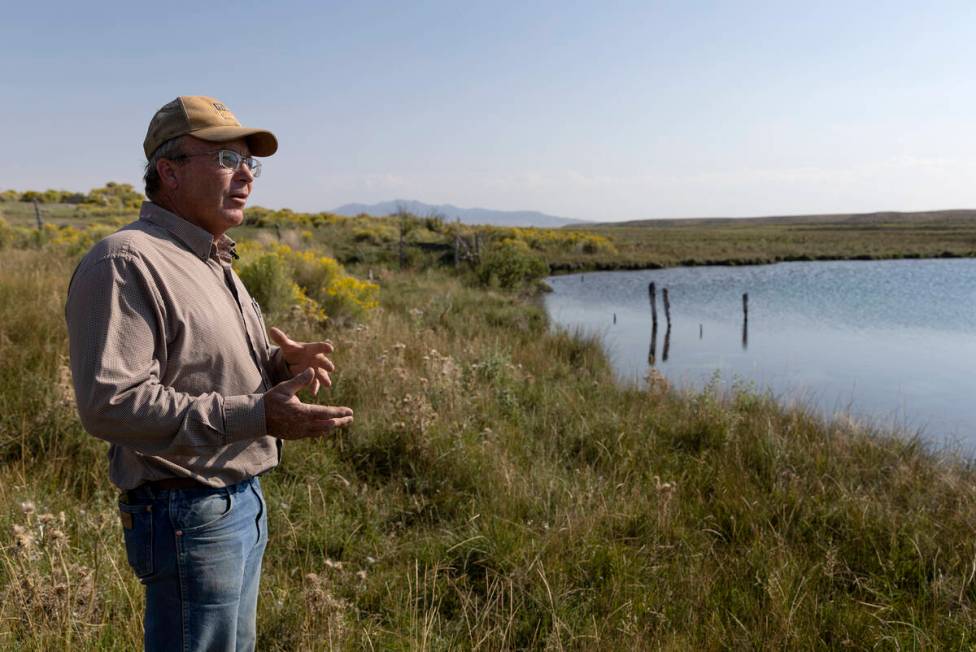See the Great Basin’s rapid groundwater loss from the sky

The water that Nevada pumps from the ground has always been hard for scientists to track. It turns out all they had to do was measure it from outer space.
Using measures of gravity from NASA satellites, scientists have shown that the Great Basin is losing its precious water resources rapidly — and snowpack isn’t replenishing them fast enough.
The study, published this year, reveals that since 2002, total water storage — including surface water, soil moisture and groundwater — has been reduced by the equivalent of the current volume of Lake Mead, multiplied by six. Water depletion has picked up since 2012, an explanation for which Hall said would require further study.
“As people tap into their groundwater, it’s diminishing,” said Dorothy Hall, a University of Maryland researcher who led the study. “It’s being replenished every year by snowfall, but not enough to keep it from declining.”
The Great Basin doesn’t include all of Southern Nevada, but it spans most of the state, also bleeding into half of Utah and parts of Idaho, Wyoming, Oregon and California. Study maps show Southern California experiencing the worst of it, likely because of agriculture in regions like the Imperial Valley, where water managers hope to pay farmers to not make use of their Colorado River water rights.
Still, findings from the study underscore a major problem for residents in rural Great Basin communities, where groundwater is a lifeline for those who rely on domestic wells. Nevada’s limited agricultural exports could be at risk, too, in the long term.
While the wider Colorado River Basin experienced two above-average years of snowpack in 2023 and 2024, Hall said the study is evidence that drought conditions are outpacing the Earth’s natural water replenishment through snow.
“If we could keep that up, it might help,” Hall said. “But it’s variable, and you can’t predict that.”
How does the technology work?
Taking readings of gravity from NASA’s fleet of GRACE/FO satellites, scientists have been able to measure water storage across the world, said Jay Famiglietti, an Arizona State University professor who pioneered the research method in the late ’90s.
Famiglietti best describes the satellites as a scale measuring water mass through gravity readings. For instance, if a region has experienced a big snowstorm, a satellite will move down in response to a greater gravitational pull, he said.
“That position of the satellite is measured with unbelievable accuracy,” Famiglietti said. “By tracking the position of this scale infrastructure in the sky, we’re able to map out the regions around the world that are gaining or losing water mass every month.”
Paying attention to groundwater levels, which Hall and her colleagues found accounts for most of the Great Basin’s water loss, is key in regions that export food, he said.
Precise measurements can be helpful for evaluating groundwater management plans, too. A 2022 paper he co-authored showed that groundwater decline is accelerating, despite California’s Sustainable Groundwater Management Act, passed in 2014.
“We grow a lot of food and use a lot of groundwater,” Famiglietti said. “Every drop of water is precious.”
A baseline for Great Basin water management
The implications of ramped-up groundwater depletion for the Great Basin could be wide-reaching.
Kyle Roerink, executive director of the water advocacy group Great Basin Water Network, said Hall’s study is illuminating, especially for Nevada.
The signs of groundwater depletion are everywhere, he said. As springs dry up, rural residents are forced to drill groundwater wells deeper to access water, and disputes are intensifying between water rights holders.
The data from the study, though, is helpful to establish groundwater levels in Nevada, Roerink said. Some of the state’s most recent accounting of groundwater dates back to the 1950s.
He hopes studies like this will inspire Nevada’s lawmakers and officials to fund water-saving programs like the Nevada Water Resources Initiative and programs to retire water rights for good.
“This report highlights the dire circumstances that we’re facing and the need to change our behaviors,” Roerink said. “There’s more conflict, more uncertainty and more of a need for money.”
Contact Alan at ahalaly@reviewjournal.com. Follow @AlanHalaly on X.